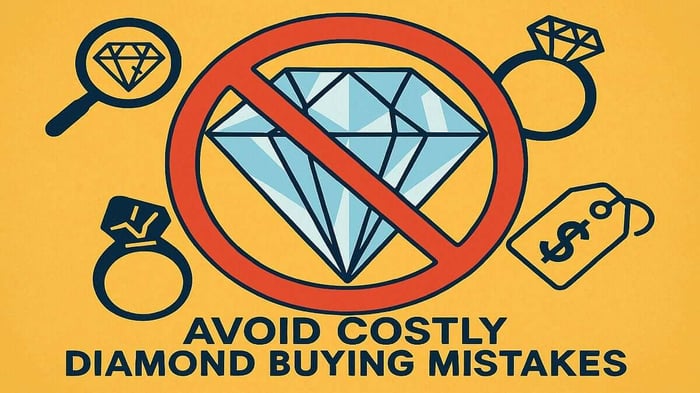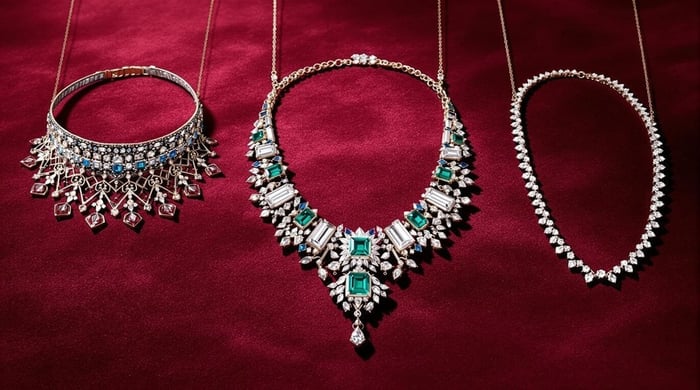Table of Contents
- Article Summary
- Misplaced Trust in Diamond Certificates Alone
- Overlooking the Vital Role of Diamond Cut Quality
- Assuming All Certification Labs Are Created Equal
- Misinterpreting Technical Grades as Indicators of Beauty
- Prioritising Carat Weight Over Optical Performance
- Confusing Clarity Ratings and Actual Visual Clarity
- Neglecting Independent Verification and Expert Opinions
- How to Shop Smarter: What These Stories Teach Us
- Looking for a Better Diamond Buying Experience?
Buying a diamond ring in Britain can sometimes feel riskier than manoeuvring through a minefield blindfolded. Many shoppers place too much trust in flashy EGL certificates, only to later realise not all labs grade diamonds equally. "I thought higher carat meant better sparkle," confessed one buyer, who learnt the hard way about the importance of cut quality. These costly diamond buying mistakes reveal essential lessons—and a few surprising truths—about diamond shopping that every buyer should know.
Article Summary
- Shoppers regret trusting EGL certificates, discovering inflated diamond grades and paying excessive prices for inferior quality stones.
- Many British buyers overlooked diamond cut quality, resulting in dull diamonds despite impressive colour and clarity grades.
- Customers mistakenly bought higher clarity and colour grades, later realising lower grades appeared visually identical and cost significantly less.
- Buyers faced financial losses after neglecting independent verification, leading to disputes over diamond authenticity and insurance complications.
- Individuals admitted relying solely on dealer recommendations, resulting in biased evaluations and purchases lacking proper third-party certification.
Cluster Diamond Earrings 1.00ct G/SI Quality in 18k White Gold

€1.473,95
A whole carat of hand-cut diamonds has been prepared and polished in the UK to our artisan’s exacting standards. Each diamond is then securely set with care in exquisite 18k white gold. Every aspect of these luxurious earrings is designed… read more
Misplaced Trust in Diamond Certificates Alone

Although diamond certificates seem trustworthy, relying on them alone can lead buyers into costly mistakes. Certificate reliability varies significantly between labs, creating confusion and hidden traps.
Diamond certificates may seem reliable, but inconsistent grading standards across labs can mislead buyers into expensive and avoidable mistakes.EGL certifications, for instance, often inflate grades by one or two levels compared to GIA reports. IGI and HRD likewise apply looser standards, meaning consumers might unknowingly purchase inferior stones. EGL even introduced a new clarity grade called SI3 to address discrepancies between their grading standards and those of more stringent labs like GIA.
This inconsistent grading impacts consumer awareness, making it harder to judge true diamond quality or value. Diamonds certified by EGL might look like affordable bargains but frequently cost more than similar GIA stones because of overstated quality claims.
Buyers who trust these inflated certificates face additional risks:
- Lower resale values later on.
- Higher retail markups hiding certification costs.
- Difficulty obtaining financing or insurance acceptance.
Note on EGL Certification:
While some buyers, have found that EGL grades can be more generous compared to stricter labs like GIA or AGS, it's important to understand that different grading labs use different standards. EGL-certified diamonds can still offer good value, especially for buyers prioritising size and budget. The key is to compare certifications carefully and always view the diamond in person when possible.
Ruby & Diamond Tennis Bracelet 2.35ct in 18k Yellow Gold

€2.512,95
This dazzling ruby and diamond bracelet makes an elegant gift or a decadent treat just for you. The intense red of the ruby creates a striking contrast to the sparkling ethically sourced G/SI quality diamonds. Set in 18k yellow gold… read more
Overlooking the Vital Role of Diamond Cut Quality
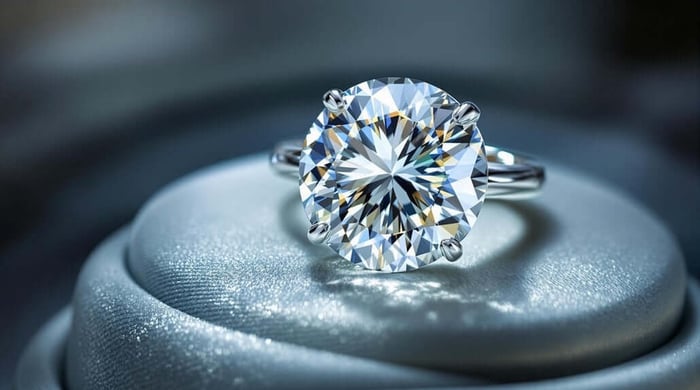
Even though many British diamond shoppers carefully check carat weight, colour, and clarity, they're often missing a crucial detail: diamond cut quality.
Cut quality directly affects a diamond's light performance, determining its sparkle and beauty. A poorly cut stone, even with high clarity or colour grades, can look dull and lifeless due to light leakage. Precision in cutting allows effective light performance, maximising a diamond's brilliance, fire, and scintillation. The choice of claw setting or other techniques can significantly influence how light interacts with the diamond.
Industry experts highlight why cut quality matters. "It's the most important factor for visual appeal," says gemologist Sarah Evans. Round brilliant cuts, crafted with precise proportions and symmetry, beautifully improve brilliance. Mixed-cut designs like Tiffany True® offer dynamic effects by combining different facets.
Shoppers pursuing diamonds that truly sparkle should prioritise:
- Precise proportions (depth, girdle, table)
- Symmetry and facet alignment
- Polished surface finish
Ignoring these details may result in a disappointing purchase.
Assuming All Certification Labs Are Created Equal
Many British diamond buyers carefully check carat, colour, clarity, and now hopefully cut quality, too.
Yet, one costly mistake involves certification misconceptions—assuming all labs hold equal standards. They're not alike, and this misunderstanding frequently leaves buyers disappointed.
Industry insiders stress the importance of lab standards. GIA, the trusted benchmark, remains strict and consistent, whereas GCAL likewise offers robust accuracy guarantees. GIA's grading reports assess cut grades only for round diamonds, making ideal proportions critical to distinguish true quality.
Conversely, labs like EGL and IGI often face criticism for lenient or inconsistent grading.
Real buyers have acquired valuable knowledge through experience. "I bought an EGL-certified diamond that seemed a bargain," says one shopper. "When reselling, I discovered its clarity was overstated, significantly reducing its value."
To avoid challenges:
- Choose GIA or GCAL for high-value diamonds.
- Cross-check certifications carefully.
- Remember, reliable grading safeguards your investment.
Tension Set Diamond Bangle 0.33ct G/SI Diamond in 18k White Gold

€2.604,95
This Diamond Bangle in 18k White Gold is designed to be worn on the hand. This bangle adds classic elegance to any outfit. Most popular as an engagement gift for women, this bangle is more than just a fashion accessory.… read more
Misinterpreting Technical Grades as Indicators of Beauty
When shopping for diamond jewellery, many British buyers mistakenly assume that a high-grade certificate automatically means the stone is more beautiful. However, London-based jeweller Anna Thompson cautions that "technical grades from certification labs don't always translate into visual appeal," pointing out that diamonds graded lower (G-J) can often appear just as stunning. Additionally, many experts emphasise the importance of evaluating diamonds in person, as even similarly graded stones can vary significantly in their crystal quality. Furthermore, understanding the Four Cs can help shoppers make more informed decisions beyond just relying on grades. Numbers on a report can't define beauty—only personal observation and preference can determine what truly dazzles.
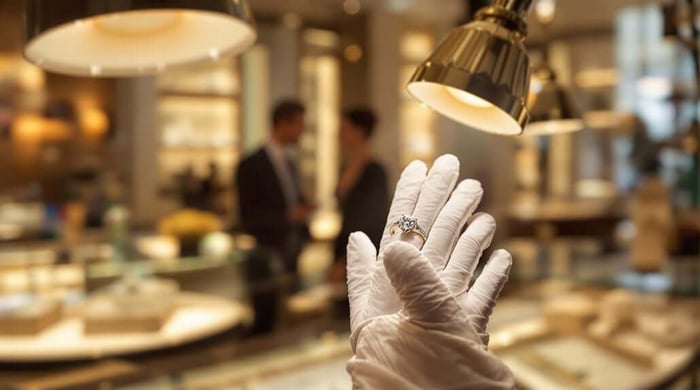
Grades Vs Visual Appeal
If shoppers rely too heavily on technical diamond grades, they might end up paying extra for beauty they can't actually see.
Colour perception, for instance, can mislead buyers. Diamonds graded G-H often look colourless to the naked eye, yet shoppers pay significantly more for D-F grades. The diamond colour scale established by the GIA grades diamonds from D to Z, with colourless grades being the rarest and most valuable.
Clarity misconceptions likewise misguide choices. VS1 or VS2 clarity diamonds appear eye-clean, making expensive Flawless grades unnecessary.
Here's why visual appeal matters more than grades:
- G-H diamonds sparkle similarly to pricier D-F diamonds without noticeable tint.
- VS clarity stones offer eye-clean beauty at a fraction of Flawless prices.
- Yellow or rose gold settings mask subtle colour differences effectively.
- Superior cut quality greatly improves brilliance, overshadowing minor imperfections.
Choosing diamonds visually guarantees shoppers find beauty they truly appreciate.
1.00ct G/SI 3 Row Diamond Pave Set Full Eternity Ring in 18k White Gold

€1.901,95
The three rows of ethically sourced, hand-cut G/SI quality diamonds with a total weight of 1.00ct seem to unfurl like a beautiful ribbon of stars around a pristine 18k white gold band. The UK hallmarked 18k white gold only accentuates… read more
Certification Laboratory Variances
Even savvy diamond shoppers often misunderstand certification reports as guarantees of visual beauty. Certification discrepancies between labs can lead buyers astray, causing costly misjudgements. For example, EGL tends to grade diamonds more leniently than GIA or IGI. Rapaport's 2013 study confirmed these grading inconsistencies, showing EGL assigning higher clarity grades, inflating a diamond's perceived value.
Differences in assessment methods likewise create confusion:
- EGL introduced an SI3 clarity grade, which GIA doesn't recognise.
- Labs interpret inclusions differently, so a VS2 at GIA might become an SI1 at IGI.
- Colour grades can mismatch between labs, even with identical diamonds.
Some labs, like GCAL, offer guaranteed grading reports, which include detailed analyses of diamonds' light performance, adding another layer of confidence for buyers.
Knowing these certification variances helps shoppers feel confident and informed. It empowers them to question potentially misleading grades and prevents expensive regrets.
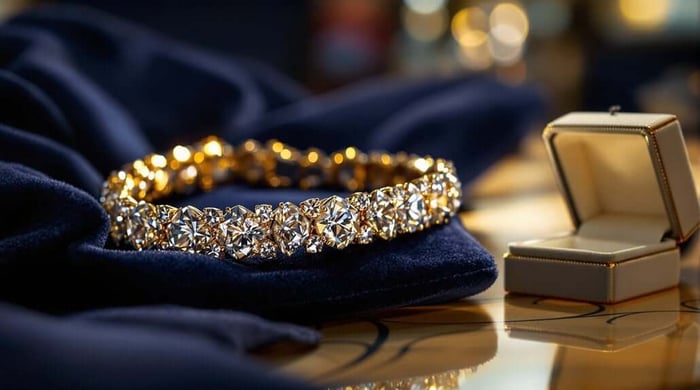
Numbers Don't Define Beauty
Many diamond shoppers rely heavily on grading numbers, believing they accurately reflect a diamond's beauty.
Nevertheless, technical grades don't always match visual perception or personal preference. Diamonds with lower clarity or colour grades can often appear just as stunning as their higher-rated counterparts. Strategic trade-offs between colour and clarity can lead to significant savings without compromising visual appeal.
Consider these points before judging beauty solely by numbers:
- Colour isn't everything: G-H diamonds often look identical to pricier D-F grades in everyday settings.
- Clarity surprises: SI1/SI2 diamonds frequently appear flawless without magnification.
- Cut quality matters most: A well-cut smaller stone can outshine a larger, poorly cut diamond.
- Visual synergy counts: Settings and fluorescence can improve a diamond's appearance beyond grading standards.
True beauty emerges through personal connection, not merely technical reports.
18k Yellow Gold 0.55ct G/SI Diamond Three Stone Bezel Set Ring

€1.473,95
Three handcrafted round-cut and ethically sourced G/SI quality diamonds that weigh 0.55 carat in a bezel setting are placed with precision on luxurious 18k yellow gold. This three stone, bezel-set, diamond ring is a timeless classic, presented to you with… read more
Prioritising Carat Weight Over Optical Performance
Even though most shoppers understand diamonds sparkle best when cut correctly, a surprising number still choose carat weight over optical quality.
Many buyers surprisingly prioritise diamond carat weight, overlooking the importance of cut quality for maximum sparkle and brilliance.This weight prioritisation often stems from common carat misconceptions influenced by clever marketing. Consumers mistakenly assume bigger diamonds always look better, but this isn't necessarily true.
Industry experts reveal that 90% of diamonds are cut to retain maximum weight, sacrificing brilliance. To retain weight, cutters compromise on table size (the flat top facet) and pavilion angle (the bottom facets), which are essential for sparkling reflections. Properly proportioned diamonds, especially those with an ideal depth percentage, produce superior sparkle and brilliance.
Interestingly, buyers can save money with "under-size" diamonds—like choosing 0.99ct instead of 1ct—that appear equally impressive if optimised for proportions.

Confusing Clarity Ratings and Actual Visual Clarity
Shoppers don't just get confused about diamond size—they often misunderstand clarity ratings too. Common clarity misconceptions lead buyers to pay extra for grades that don't always mean better visual quality.
Here's how inclusion visibility can differ from expectations:
- FL, IF, VVS confusion: Buyers assume these top clarity grades look identical, unaware that IF diamonds may still have surface blemishes. Central diamond quality can significantly influence overall appearance.
- VS2 assumptions: Many believe all VS2 diamonds appear perfectly clear, but larger stones over 2 carats can display visible flaws.
- SI variability: SI grades vary widely—some SI1 diamonds seem flawless, yet others clearly show inclusions.
- Shape matters: Emerald and cushion cuts highlight inclusion visibility more than round shapes, even at the same clarity level. Diamonds are graded by professionals who assess inclusions under 10x magnification.
Understanding these subtleties helps shoppers find diamonds they'll truly cherish.
Channel Set Trilogy Princess Ring 0.33ct G/SI Quality 18k White Gold

€1.046,95
This beautiful ring has been handcrafted by our expert jewellers. It is made of high quality 18k white gold and includes a diamond centre stone. The channel set design is beautiful and modern. The ring is suitable for everyday use… read more
Neglecting Independent Verification and Expert Opinions
When purchasing diamond jewellery, it's tempting to rely solely on dealer recommendations and skip independent verification—but this can be an expensive mistake.
Dealer assessments often lack the impartial quality validation provided by independent assessments from accredited gemstone labs like GIA or IGI. Without expert appraisals, buyers risk falling prey to biased evaluations or even misrepresentation. Certification from respected laboratories typically includes critical diamond attributes such as the 4 C’s, fluorescence and polish, offering comprehensive insight into your diamond's true value.
Certified documentation helps prove authenticity, supports higher resale value, and simplifies insurance claims. Neglecting independent verification means no documented proof of vital diamond characteristics, complicating ownership verification and insurance disputes.
Certified documentation safeguards authenticity, enhances resale potential, and streamlines insurance claims, protecting your valuable diamond investment from costly disputes.To avoid costly diamond buying mistakes:
- Always request certificates from recognised laboratories.
- Pursue impartial expert appraisals.
- Remember, relying on trusted third-party evaluations isn't just smart—it's critical protection for your valuable investment.
How to Shop Smarter: What These Stories Teach Us
It’s easy to get swept up in the moment when you’re shopping for something as exciting (and emotional) as diamond jewellery—but these stories all share a simple truth: a little caution goes a long way. If you’re planning to buy, here are a few takeaways worth keeping in your back pocket:
Don’t buy under pressure. A limited-time offer is rarely as limited as it sounds. Take your time.
Know your grading labs. GIA and AGS are known for strict, consistent standards. Others, like EGL, may grade more generously — which can mean you're not getting what you think you are.
Compare more than prices. Two diamonds can look identical on paper but be very different in real life. View them side by side if you can.
Ask questions — and trust your gut. If something feels off or too good to be true, pause. A good jeweller will respect your need to think things through.
Consider an independent appraisal. Obtaining a second opinion, particularly for high-value stones, can provide peace of mind prior to making any financial decisions.
Oval 1.15ct Emerald 0.50ct Diamond Cluster Ring 18k Yellow Gold

€2.408,95
Over a carat of lustrous emerald framed in half a carat of exquisite G/SI quality diamond. All brought to a focus on a band of warm 18k yellow gold. A truly memorable example of the very best in UK handcrafted… read more
Looking for a Better Diamond Buying Experience?
These real-life stories show just how easy it is to make costly diamond buying mistakes — but they don’t have to be your story. At All Diamond, we believe in doing things differently.
Every piece in our collection is designed and handcrafted right here in the UK, using only ethically sourced, natural diamonds and gemstones. Our expert artisans take pride in their work — and we back it up with a lifetime workmanship guarantee, so you can buy with confidence.
Most importantly, you don’t have to decide under pressure. When you order from us, you get 30 days after delivery to try your jewellery on at home, under natural lighting, and make sure it feels exactly right for you.
If you're ready for a more thoughtful, transparent, and enjoyable way to buy fine diamond jewellery, we’d love to show you what we offer.
👉 Browse our collections of fine, natural diamond jewellery at All Diamond.
